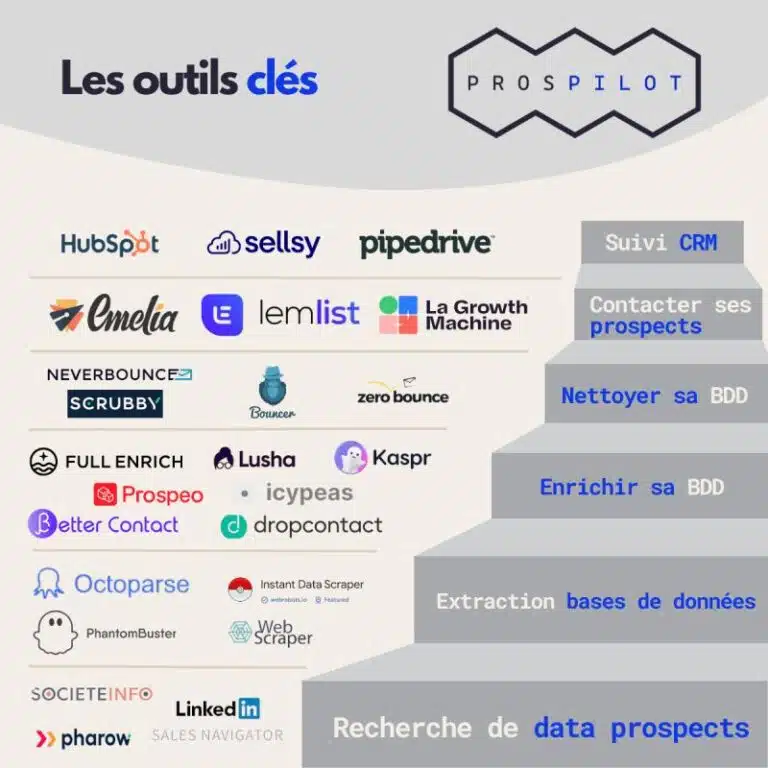
You have implemented a solid BtoB prospecting strategy. However, are you noticing decreases in your conversion rates, especially during the summer? This phenomenon, although common, can be frustrating and significantly impact your business results.
What do we mean by prospecting conversion rate? This is the percentage of qualified leads that turn into customers. This rate is a key performance indicator (KPI) that allows you to assess the effectiveness of your commercial actions. It is calculated as follows: Number of customers/Number of visitors x 100
Why do conversion rates fluctuate? There are many factors that can explain these variations, including:
- Seasonality: Vacation periods, economic events or new product launches can influence the buying behavior of your prospects.
- The competition: A more dynamic market or the arrival of new competitors can make winning new customers more difficult.
- The evolution of customer needs: The expectations and criteria for choosing your prospects can change rapidly, making your offers less relevant.
- The fatigue of prospecting: An approach that is too repetitive or messages that are not very personalized can cause fatigue among your prospects.
Faced with these challenges, it is essential to put in place strategies to maintain high conversion rates throughout the year. In this article, we are going to explore the main reasons for the declines in conversion. We will also offer you concrete solutions to optimize your commercial approach.
The internal reasons for the drop in your conversion rates

Although external factors can influence your results, it is essential to look at the internal elements of your prospecting strategy.
- Quality of your database: Outdated, incomplete, or poorly segmented data can hinder the effectiveness of your campaigns. So be vigilant and clean your databases well to avoid ending up in spam or having undeliverable email addresses.
- Customizing your messages: Generic and non-personalized messages will not arouse the interest of your prospects. It is therefore important to find a problem they are facing to challenge them and to add variables such as name, first name, company...
- Quality of your sales pitch: A speech that is too complex, vague or poorly adapted to the needs of your target audience can slow down conversion. That's why you need to be able to summarize your value proposition in one or two sentences maximum.
- Monitoring and analysis of your results: A lack of monitoring and analysis prevents you from identifying the weak points of your strategy. Consider equipping yourself with a CRM such as Sellsy that can allow you to centralize everything (documents, invoices, information...).
Optimize your targeting

As I said before, to improve your conversion rate, it is essential to refine your targeting.
- Advanced segmentation: Segment your database according to specific criteria (industry, company size, specific needs) to offer personalized offers but also to be able to highlight a problem they are facing. A problem that will not be the same depending on your segmentation.
- Enrichment of your data: Use data enrichment tools to complete your information and better understand your prospects. In particular, you have BetterContact that allows you cascading enrichment.
- Regular update of your database: Make sure your data is always up to date to avoid contacting inactive prospects with the wrong email address that would damage the reputation of your domain name.
Personalize your approach

La personalizing is also a key element in improving your conversion rates in BtoB prospecting. Indeed, each prospect is unique and has specific needs. By adapting your approach, you not only demonstrate your professionalism, but you significantly increase your chances of generating interest and creating a relationship of trust.
Why is personalization so important for converting?
- It makes your message more relevant: By targeting the specific needs of each prospect, you show that you have taken the time to learn about them and their business. It makes your proposal much more believable and appealing.
- It creates a sense of value: When prospects feel understood and valued, they are more likely to pay attention to your offer.
- It differentiates from the competition: In a saturated market, personalization is an effective way to stand out and leave a lasting impression.
- It improves the customer experience: A personalized experience from the first contacts promotes the establishment of a long-term relationship of trust.
How do you personalize your approach?
- Collect relevant data: The more information you have about your prospects, the more you can personalize your exchanges. Use data enrichment tools to complete your databases.
- Segment your database: Create prospect segments based on specific criteria (industry, business size, specific needs) to adapt your messages.
- Personalize your emails: Use dynamic fields to insert the name of the prospect, the name of their company, or references to their current projects.
- Adapt your telephone speech: Prepare a personalized pitch based on the profile of each prospect.
- Create personalized content: Offer case studies, webinars, or demonstrations tailored to the specific needs of each segment.
Innovating in your approach to conversion

A/B testing is a scientific method that consists in comparing two versions of an element (email, landing page, etc.) in order to identify which one offers the best results. By applying this method to your prospecting, you can refine your strategy and, once again, improve your conversion rate in a measurable way.
Why does A/B testing impact your conversion rate?
- Identify the most efficient elements: By comparing different versions, you can determine which elements (email subject, call to action, etc.) have the most impact on the behavior of your prospects.
- Making decisions based on data: A/B testing allows you to make informed decisions based on concrete results rather than intuition.
- Continuously improve your strategy: By conducting A/B tests on a regular basis, you can continuously optimize your prospecting strategy and achieve better results.
How do I set up A/B tests?
- Choose an item to test: Start by identifying a specific element that you want to improve, such as the subject of your email, the content of your landing page, or when to send your campaigns.
- Create two versions: Create two versions of the item you want to test. These two versions should be the same in every way except for the item you want to test.
- Divide your audience: Divide your audience into two equally sized groups. One group will get version A, the other group will get version B.
- Measure the results: Track and compare the results of each version. Use the key performance indicators (KPIs) relevant to your objective (open rate, click rate, conversion rate, etc.).
- Analyze the results and make a decision: Once you've collected enough data, analyze the results and draw conclusions. Choose the version that got the best results and implement it for your entire audience.
What items can you test?
- Email topics: Experiment with different formulations to find the topic that gets the most openness.
- The content of the emails: Test different structures, arguments, or calls to action.
- Landing pages: Experiment with different layouts, offerings, or visuals.
- Shipping times: Experiment with different times of the day to send your emails.
- Prospecting channels: Compare the results obtained on different channels (email, LinkedIn, etc.).
A/B testing tools
There are a number of tools that can help you set up A/B testing, including:
- Emailing tools: Most emailing tools offer A/B testing features.
- Marketing automation software: This software allows A/B tests to be carried out on various channels.
- User experience platforms: These platforms allow you to perform A/B tests on your websites and applications.
Monitoring and analyzing your results affects the conversion rate

Finally, to continuously improve your performance, it is essential to set up a rigorous monitoring and analysis system. This will allow you to identify which actions are working and which are less effective, in order to adjust your strategy accordingly.
1. Define your KPIs
Key performance indicators (KPIs) are metrics that allow you to measure the effectiveness of your commercial actions. In BtoB prospecting, the most important KPIs are:
- Email response rate : This KPI shows you the percentage of prospects who open and respond to your emails.
- Rate of appointments obtained : This KPI measures your ability to turn qualified leads into appointments.
- Customer conversion rate : This KPI indicates the percentage of appointments that result in a sale.
- Average length of a sales cycle : This KPI allows you to assess how long it takes to close a sale.
- Cost per customer acquisition (CAC) : This KPI measures the average cost of acquiring a new customer.
2. Set up a dashboard
In addition, a dashboard allows you to visualize the evolution of your KPIs over time and to quickly identify trends. You can use tools like Google Data Studio, Tableau, or CRM solutions to create a personalized dashboard.
3. Analyzing the data
Once you have reliable data, it's time to analyze it to learn from it. Ask yourself the following questions:
- Which prospecting channels are the most efficient?
- What types of messages are getting the most interest?
- At what time of day is it best to contact prospects?
- What are the most receptive prospect profiles?
- What are the main obstacles to conversion?
4. Adjust your strategy
Finally, based on the results of your analyses, you can adjust your prospecting strategy:
- Optimize your messages : Change the content, tone, or structure of your messages to make them more effective.
- Improve your targeting : Refine your segmentation to target more qualified prospects.
- Testing new channels : Explore new prospecting channels to reach a wider audience.
- Change your sales process : Adapt your sales process to reduce cycle time and improve customer experience.
The conversion rate: what to remember
In conclusion, optimizing conversion rates in BtoB prospecting requires a global and personalized approach. By combining precise segmentation of your database, extensive personalization of your messages, regular A/B tests and rigorous monitoring of your results, you will be in a position to significantly improve your commercial performance. Remember that the BtoB landscape is constantly evolving. It is therefore essential to stay on top of new trends and adapt your strategy accordingly.
You could Love also
Discover how we transform your targets
Strategy, copywriting, data, multi-channel reminders: we show you concretely how to manage your prospecting, from A to Z.

Let's discuss your
Want to take things to the next level?
We help you structure and execute effective prospecting, human and efficient.




